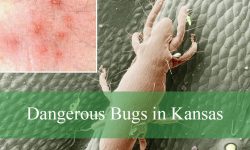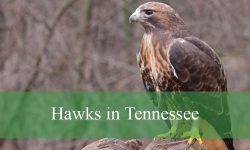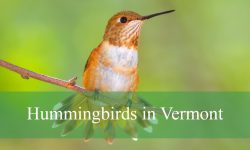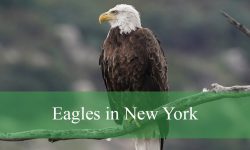Across Minnesota’s lakes, wetlands, and prairie potholes, a rich diversity of duck species thrives, from common dabblers like Mallards to striking divers like Canvasbacks. Birdwatchers and nature enthusiasts can enjoy spotting these waterfowl throughout the year.
Ducks vary in size, plumage, and behavior, making identification both exciting and challenging. Observing their vibrant colors, unique bills, and social habits reveals fascinating traits for each species.
Spring and fall migrations bring the highest diversity, offering a perfect opportunity to see rare and seasonal species. Understanding their preferred habitats and feeding behaviors helps in spotting and enjoying these ducks effectively.
Common Ducks Found in Minnesota
Mallard (Anas platyrhynchos)
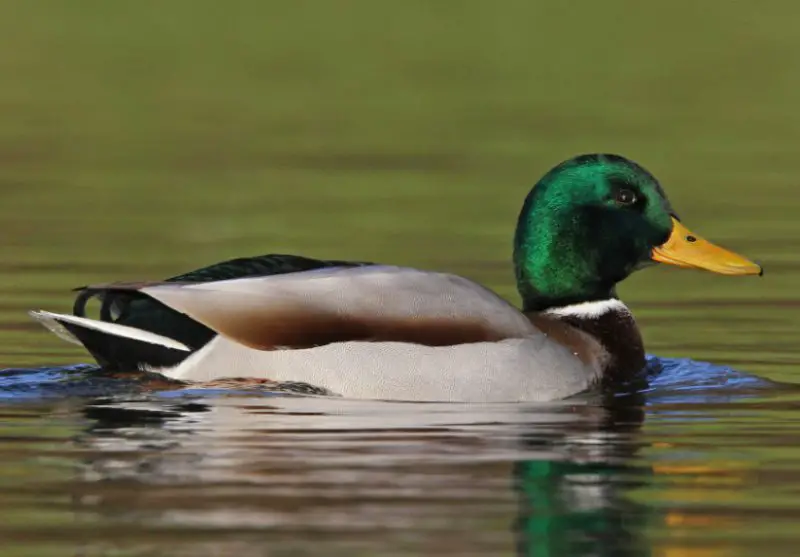
The Mallard is one of the most recognizable and widespread ducks in Minnesota. Males display a glossy green head, white neck ring, and chestnut-brown chest, while females are mottled brown with an orange bill. Both sexes have a distinctive blue speculum bordered by white on the wings, which is visible in flight. Adult Mallards typically measure 50–65 cm in length with a wingspan of 81–98 cm, weighing 1–1.3 kg.
Mallards are highly adaptable and can be found in a variety of freshwater habitats, including lakes, rivers, marshes, and even urban ponds. They feed mainly on aquatic vegetation, seeds, and small invertebrates, often dabbling at the water surface or tipping forward to reach underwater plants. Mallards are also known for foraging on land, grazing on grains and grasses.
In Minnesota, Mallards are abundant year-round, with peak populations during migration in the fall and spring. They breed across the state, nesting in marshes or concealed areas near water, often returning to the same sites each year. Mallards are social birds, forming large flocks outside the breeding season and frequently associating with other dabbling duck species.
Wood Duck (Aix sponsa)
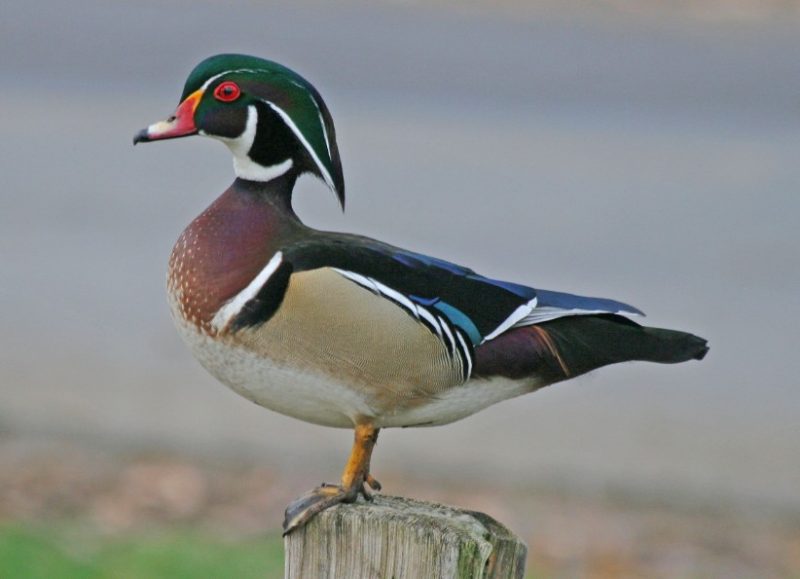
The Wood Duck is a strikingly colorful species, especially the male, which features iridescent green and purple plumage, red eyes, and ornate white markings. Females are more subdued with gray-brown plumage, a white eye-ring, and a distinctive crest. They measure 47–54 cm in length with a wingspan of 66–73 cm, weighing around 0.5–0.7 kg. Their distinctive head shape and bold patterning make them easily identifiable among North American waterfowl.
Wood Ducks prefer wooded wetlands, swamps, and ponds with abundant tree cover. They are cavity nesters, often utilizing tree holes or nest boxes near water. Their diet consists of seeds, fruits, aquatic invertebrates, and small amphibians. They are highly agile in flight and can perch on branches, unlike many other duck species.
In Minnesota, Wood Ducks are common in spring and summer for breeding, with populations concentrated in forested wetland areas. During fall migration, they move south but may overwinter in southern Minnesota if conditions allow. Their dependence on quality wetland habitat makes them indicators of ecosystem health in the region.
Northern Pintail (Anas acuta)
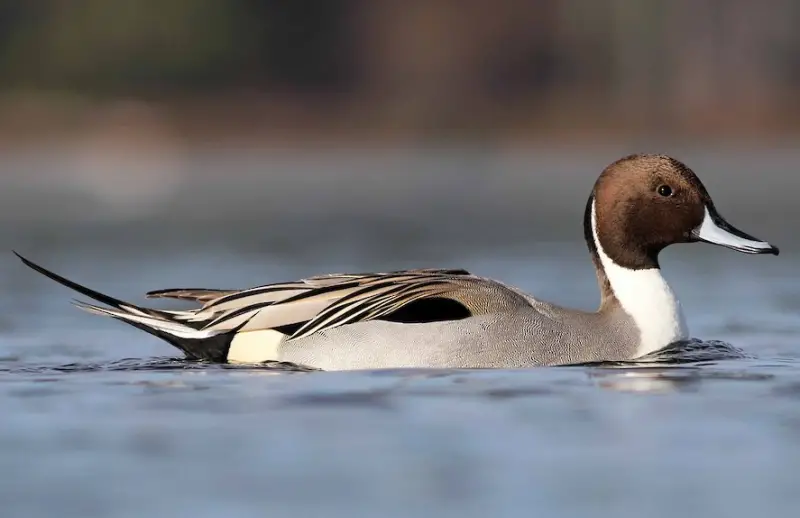
The Northern Pintail is an elegant, long-necked duck with a slender body and pointed tail. Males have a chocolate-brown head, white neck stripe, gray body, and black rear, while females are mottled brown with a lighter face and subtle tail point. Pintails measure 50–65 cm in length, with a wingspan of 82–95 cm and weight around 0.7–1.2 kg, making them slightly slimmer than Mallards.
Northern Pintails favor shallow wetlands, marshes, and prairie potholes. They are primarily dabblers, feeding on seeds, aquatic plants, and small invertebrates by tipping forward in shallow water. Pintails are known for their graceful flight and long migrations, traveling long distances between breeding and wintering grounds.
In Minnesota, Northern Pintails are most abundant during the breeding season in prairie potholes and shallow marshes across the state. They migrate through the region in spring and fall, with many moving south to the Gulf Coast or Central America. Pintails often mix with other dabbling ducks but tend to be more wary and dispersed in their feeding areas.
American Black Duck (Anas rubripes)

The American Black Duck has dark brown plumage with a slightly lighter head and pale underwings, often confused with female Mallards but distinguished by a darker overall coloration and yellowish-green bill. Males and females are similar in appearance, with males slightly brighter. Adults are 54–60 cm long, with a wingspan of 88–95 cm and weigh around 0.9–1.2 kg.
This species prefers freshwater wetlands, wooded swamps, and tidal marshes. They feed primarily on aquatic plants, seeds, and small invertebrates. American Black Ducks are mainly dabblers, often seen foraging in shallow water or along marsh edges. They are less social than Mallards but may form small flocks with similar-sized ducks.
In Minnesota, American Black Ducks are less common than Mallards, mainly occurring in forested wetland regions and along large lakes. They breed in the northeastern part of the state and migrate southward in winter, mixing with other waterfowl along migration routes. Conservation efforts focus on wetland preservation to support their declining populations.
Gadwall (Mareca strepera)

The Gadwall is a medium-sized dabbling duck with subtle, patterned gray-brown plumage in males, accented by a black rear end and white wing patch visible in flight. Females are mottled brown with a slightly duller appearance. Gadwalls measure 50–60 cm long, have a wingspan of 81–90 cm, and weigh 0.7–1 kg. They are less colorful than other ducks but recognizable by their distinct profile and wing pattern.
Gadwalls inhabit shallow wetlands, marshes, and ponds with abundant submerged vegetation. Their diet consists mostly of aquatic plants, especially pondweeds and grasses, with occasional small invertebrates. They are efficient foragers and often feed alongside other dabbling ducks, staying in large, loosely organized flocks.
In Minnesota, Gadwalls are common migrants and breeders, with breeding concentrated in prairie potholes and shallow marshes. During migration, they gather in mixed flocks with Mallards and Pintails, traveling to southern states or the Gulf Coast. They are adaptable birds but rely heavily on quality wetland habitat for feeding and nesting.
Northern Shoveler (Spatula clypeata)
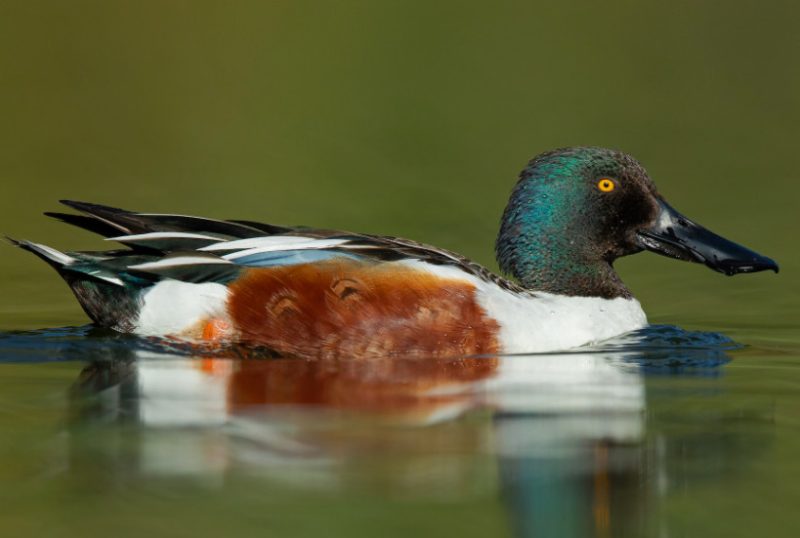
The Northern Shoveler is easily identified by its large, spatula-shaped bill. Males have striking green heads, white chest, and chestnut flanks, while females are mottled brown with the same distinctive bill shape. Adults measure 48–58 cm in length, have a wingspan of 76–91 cm, and weigh 0.6–1 kg. Their unique bill allows them to filter small invertebrates and plant matter from the water.
Northern Shovelers favor shallow marshes, wetlands, and ponds rich in invertebrates. They feed by swimming with a side-to-side motion, filtering water through their specialized bills to capture food. They often forage in small flocks and are highly social outside the breeding season.
In Minnesota, Northern Shovelers breed in shallow wetlands and prairie potholes, often in areas with dense emergent vegetation. They migrate south in the winter but may linger in southern Minnesota if water bodies remain unfrozen. Their presence indicates healthy wetland ecosystems with abundant aquatic invertebrates.
Green-winged Teal (Anas crecca)
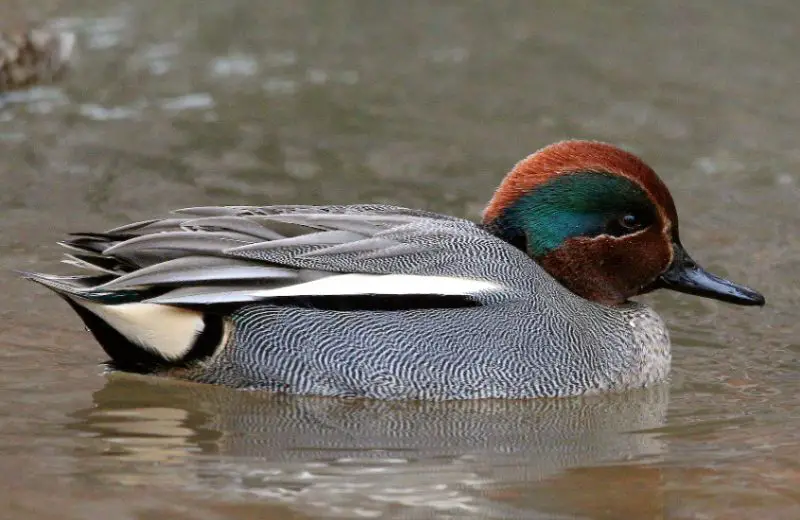
The Green-winged Teal is a small dabbling duck with a compact body and striking coloration. Males feature a chestnut head with a distinctive green eye stripe, gray body, and vertical white mark on the side, while females are mottled brown with a subtle green speculum. Adults measure 34–44 cm in length, have a wingspan of 53–59 cm, and weigh 0.3–0.5 kg. Their petite size and rapid wingbeat make them agile and quick in flight.
Green-winged Teals inhabit shallow marshes, ponds, flooded fields, and estuaries, often feeding on seeds, aquatic vegetation, and small invertebrates by dabbling near the water surface. They forage actively in both fresh and brackish water, frequently in mixed-species flocks with other small dabblers.
In Minnesota, Green-winged Teals are common migrants during spring and fall, with some remaining for breeding in northern wetlands. They prefer prairie potholes, shallow marshes, and small ponds for nesting. Their populations fluctuate based on wetland availability and water levels, making them sensitive to habitat conditions.
Blue-winged Teal (Spatula discors)
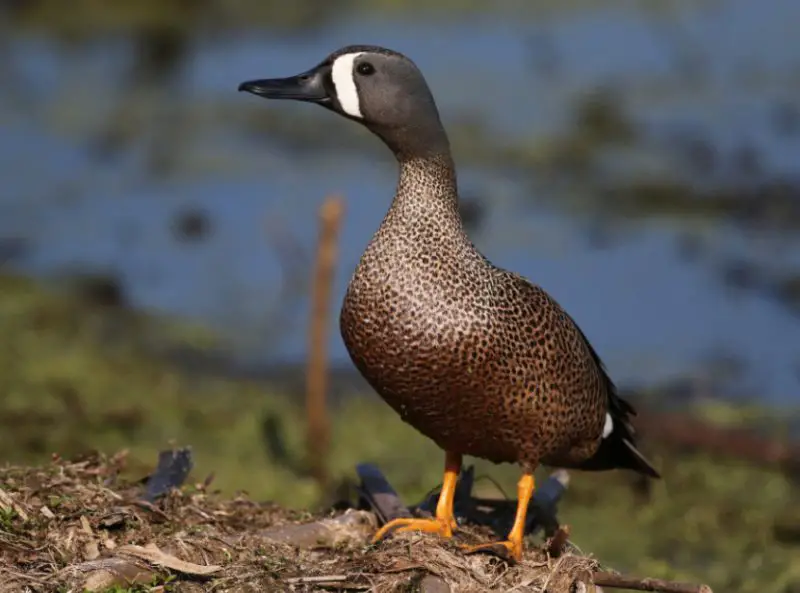
The Blue-winged Teal is a medium-sized dabbling duck known for its pale blue wing patch visible in flight. Males have a slate-gray body, white facial crescent, and reddish-brown head, while females are mottled brown with a subtle wing patch. Adults measure 40–51 cm in length, with a wingspan of 66–75 cm and weight of 0.4–0.6 kg. They are swift and acrobatic flyers, often seen in large flocks during migration.
Blue-winged Teals favor shallow wetlands, prairie potholes, flooded fields, and marshes with emergent vegetation. They feed on seeds, aquatic plants, and invertebrates by dabbling or tipping forward in shallow water. They are social ducks, often forming mixed-species feeding groups with other dabblers.
In Minnesota, Blue-winged Teals are abundant during spring and fall migrations. They breed primarily in prairie potholes and wet meadows, often nesting in dense grass near water. They migrate south for winter, with large flocks traveling to the southern U.S., Mexico, and Central America.
Cinnamon Teal (Spatula cyanoptera)
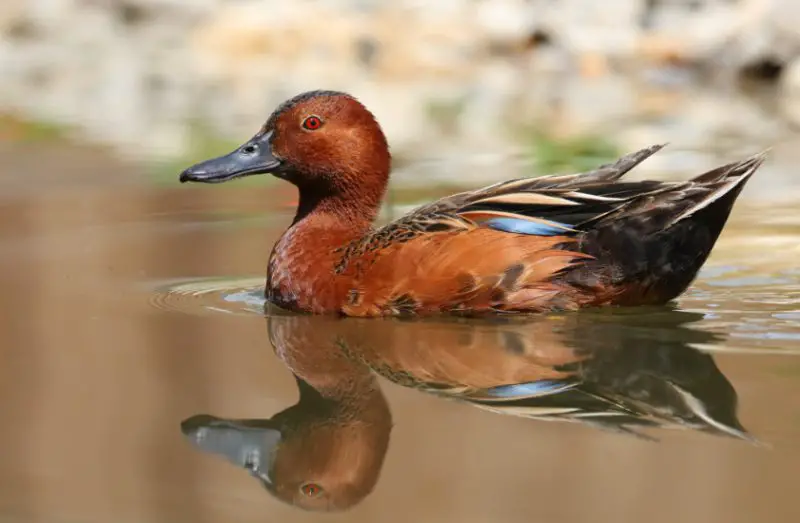
The Cinnamon Teal is a strikingly colored dabbling duck, with males displaying bright reddish-brown plumage and grayish wings, while females are mottled brown with a paler face. Adults measure 38–48 cm in length, with a wingspan of 60–70 cm and weight around 0.4–0.6 kg. Their vivid coloration makes males easy to identify, especially in breeding areas.
Cinnamon Teals inhabit shallow freshwater wetlands, marshes, ponds, and tidal flats. They feed mainly on aquatic vegetation, seeds, and small invertebrates by dabbling and filtering water through their bill. These ducks are highly migratory and prefer quiet, open wetlands for foraging and breeding.
In Minnesota, Cinnamon Teals are relatively rare, mostly seen as migrants passing through the state. They breed primarily in the western U.S. and migrate to Central and South America for winter. Sightings in Minnesota are more likely during spring and fall migration periods, often in prairie wetlands.
Canvasback (Aythya valisineria)
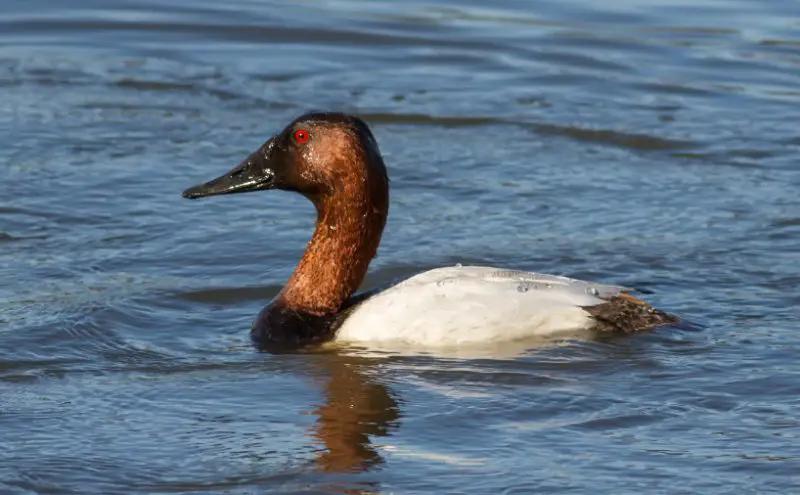
The Canvasback is a large diving duck with a distinctive sloping forehead and long, black-tipped bill. Males have a chestnut-red head, black chest, and pale gray body, while females are light brown with a darker head. Adults measure 48–56 cm in length, with a wingspan of 82–95 cm and weight of 0.9–1.4 kg. Their diving behavior and pointed profile make them easy to distinguish from other ducks.
Canvasbacks prefer deep freshwater lakes, marshes, and reservoirs with abundant submerged vegetation. They dive to feed on aquatic plants, seeds, and invertebrates, often foraging in groups. They are strong, long-distance migrants and form large flocks during migration.
In Minnesota, Canvasbacks are most commonly observed during migration and winter on larger lakes and reservoirs. Breeding occurs in prairie potholes and marshes in the northern part of the state. Their populations depend heavily on wetland availability and water quality.
Redhead (Aythya americana)
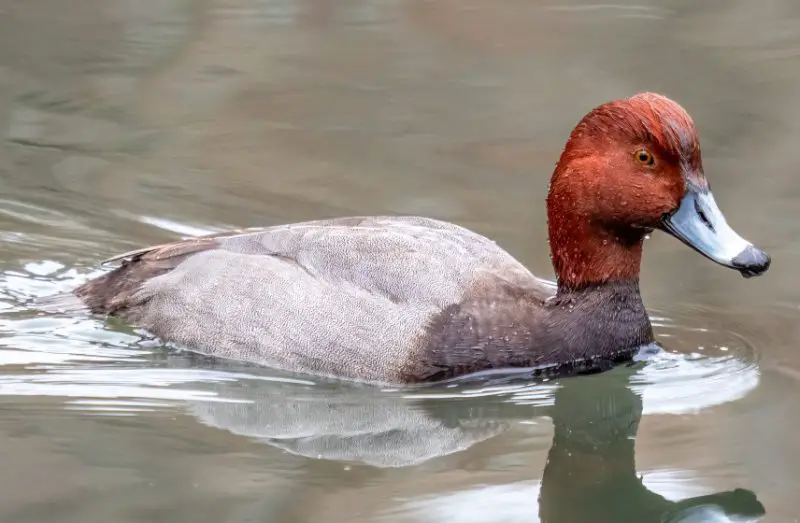
The Redhead is a medium-sized diving duck with a rounded head and distinctive coloration. Males have a rich reddish-brown head, black chest, and gray body, while females are brown with paler faces and darker bills. Adults measure 45–56 cm in length, with a wingspan of 73–86 cm and weight of 0.8–1.1 kg. Redheads are recognized for their diving skills and compact, stocky body shape.
Redheads inhabit freshwater lakes, marshes, and ponds with abundant submerged vegetation. They feed by diving for aquatic plants, seeds, and small invertebrates. They often gather in large flocks, especially on migration routes, and are known to mix with Canvasbacks and other diving ducks.
In Minnesota, Redheads are common migrants and breeders, with breeding concentrated in prairie potholes and shallow wetlands. During migration, they can be seen in large numbers on lakes and reservoirs. Their populations are sensitive to wetland loss and changes in water levels.
Ring-necked Duck (Aythya collaris)
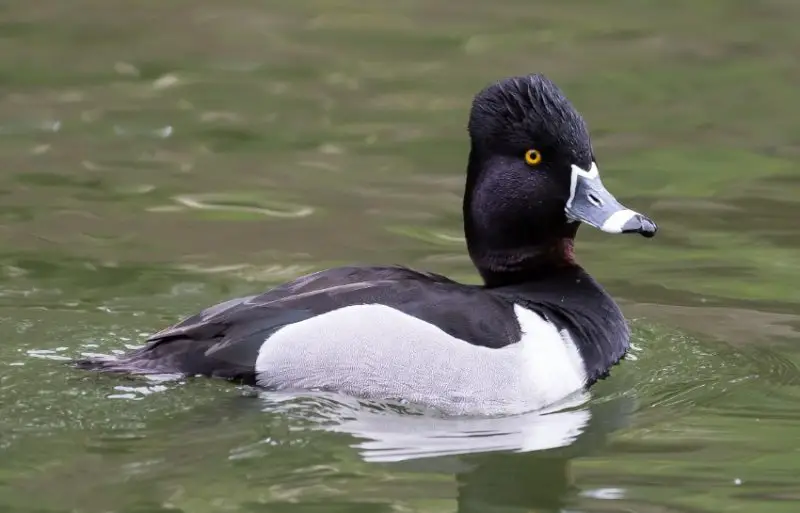
The Ring-necked Duck is a medium-sized diving duck with a distinctive peaked head. Males have a glossy black head, back, and chest with gray flanks and a subtle chestnut ring on the bill, while females are brown with a pale eye ring and grayish sides. Adults measure 40–48 cm in length, with a wingspan of 66–73 cm and weigh 0.6–0.9 kg. Their characteristic bill pattern and shape make them easy to identify.
Ring-necked Ducks inhabit freshwater lakes, ponds, and marshes, preferring areas with dense aquatic vegetation. They feed primarily by diving for seeds, aquatic plants, and invertebrates. They are active foragers and often form small to medium-sized flocks during migration.
In Minnesota, Ring-necked Ducks breed in shallow wetlands and lakes, particularly in forested and prairie regions. They migrate through the state in spring and fall, traveling to southern U.S. and Central America for winter. These ducks are common on lakes and reservoirs, especially during migration periods.
Lesser Scaup (Aythya affinis)
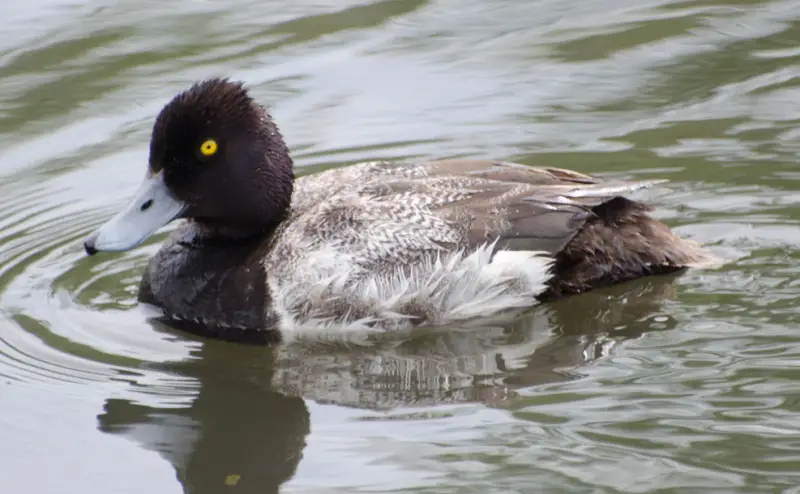
The Lesser Scaup is a medium-sized diving duck with a rounded head and compact body. Males have a glossy black head, gray body, and black chest, while females are brown with a white patch near the bill. Adults measure 38–48 cm in length, with a wingspan of 66–76 cm and weigh 0.6–0.9 kg. They are agile divers, known for their quick, bobbing movements in the water.
Lesser Scaups inhabit freshwater lakes, ponds, and marshes, often preferring areas with abundant submerged vegetation. They dive for aquatic plants, seeds, and invertebrates and frequently forage in flocks with other diving ducks. These ducks are highly social outside the breeding season.
In Minnesota, Lesser Scaups breed in prairie potholes and shallow lakes, with peak numbers seen during migration in spring and fall. They winter further south but may linger on open water in southern parts of the state during mild winters. They are common in both natural wetlands and managed reservoirs.
Greater Scaup (Aythya marila)
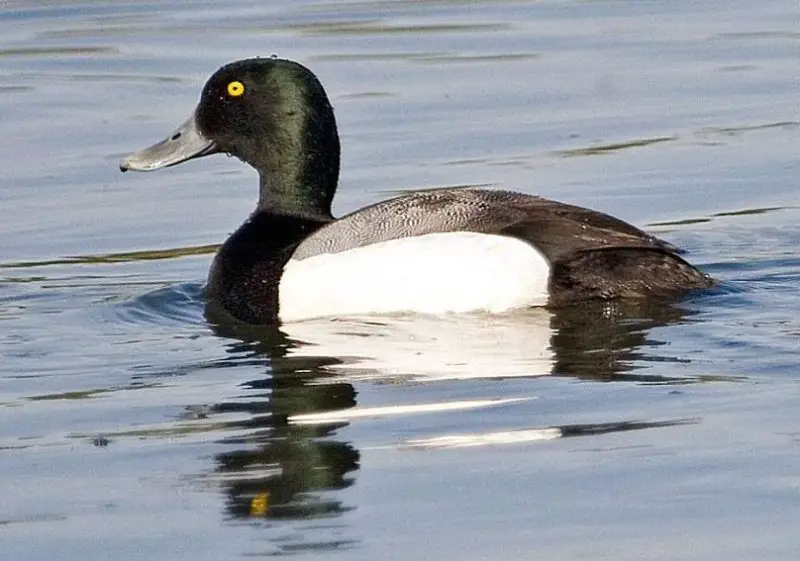
The Greater Scaup is a larger diving duck with a rounded head and stout body. Males have a dark greenish-black head, black chest, and gray body, while females are brown with pale faces. Adults measure 45–56 cm in length, with a wingspan of 71–81 cm and weigh 0.8–1.2 kg. They are strong fliers and efficient divers, often seen in large flocks on open water.
Greater Scaups inhabit deeper lakes, bays, and coastal waters, feeding by diving for mollusks, aquatic plants, and invertebrates. They are known to forage in large groups, sometimes mixed with Lesser Scaups or other diving ducks. Their flight is swift and direct, with rapid wingbeats.
In Minnesota, Greater Scaups are primarily observed during migration in fall and spring. They breed further north in Canada and Alaska and stop in Minnesota’s larger lakes and reservoirs during their journey. Their numbers in the state fluctuate depending on water levels and food availability.
Common Goldeneye (Bucephala clangula)
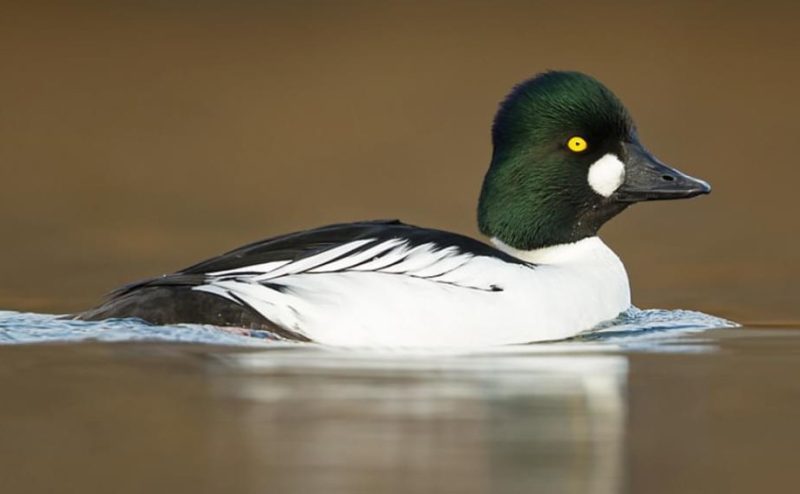
The Common Goldeneye is a medium-sized diving duck with a distinctive bright yellow eye. Males have a dark green head, white body, and black back, while females are gray with a brown head. Adults measure 46–56 cm in length, with a wingspan of 73–83 cm and weigh 0.7–1.1 kg. Their striking eye and head pattern make them easy to identify in flight or on water.
Common Goldeneyes inhabit freshwater lakes, rivers, and reservoirs, often near forested areas. They dive for aquatic invertebrates, crustaceans, and small fish, feeding alone or in small groups. They are known for their courtship displays, including head-throwing and wing-flapping behaviors.
In Minnesota, Common Goldeneyes breed in northern forested lakes and migrate through the state during fall and spring. They winter primarily on larger lakes, rivers, and coastal waters, with occasional sightings in southern Minnesota during mild winters.
Barrow’s Goldeneye (Bucephala islandica)
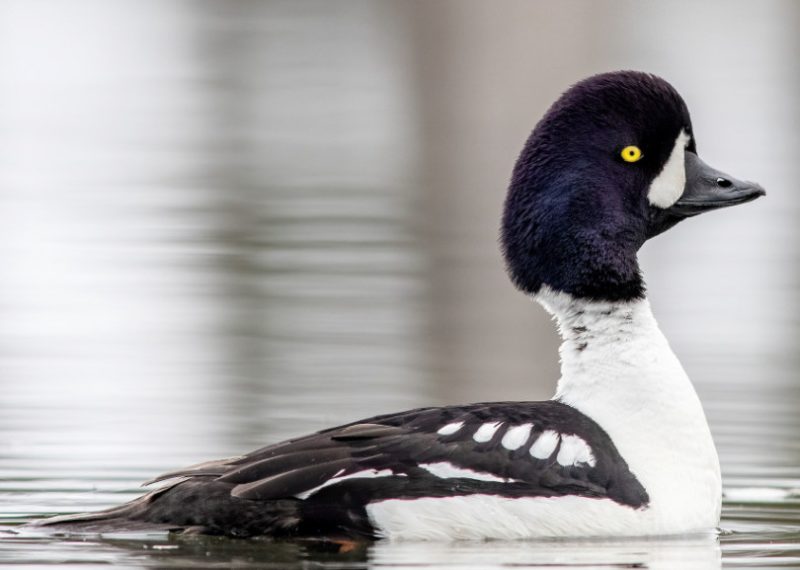
Barrow’s Goldeneye is a medium-sized diving duck similar to the Common Goldeneye but slightly smaller and with more contrasting black-and-white patterns. Males have a glossy black head with a crescent-shaped white facial patch, white body, and black back, while females are dark brown with a white patch near the bill. Adults measure 44–52 cm in length, with a wingspan of 70–78 cm and weigh 0.7–1 kg.
Barrow’s Goldeneyes inhabit forested lakes, rivers, and mountain ponds. They feed primarily by diving for aquatic insects, crustaceans, and small fish. These ducks are territorial during the breeding season but often form small flocks outside of it. They prefer clear, deep waters for foraging.
In Minnesota, Barrow’s Goldeneyes are uncommon breeders in northern lakes and are more frequently observed during migration. They migrate south to large lakes and rivers in the northern U.S. for winter, with sightings concentrated in forested regions and open water habitats.
Bufflehead (Bucephala albeola)
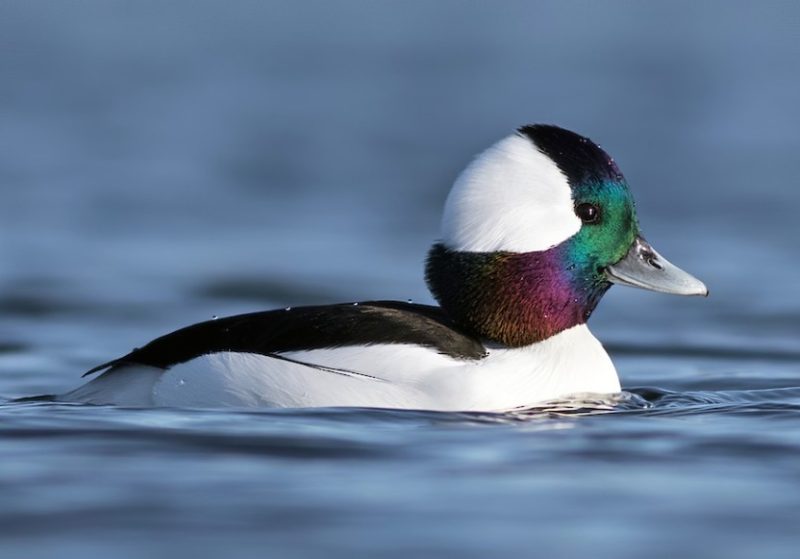
The Bufflehead is one of the smallest diving ducks, easily recognized by its compact body and large, round head. Males have iridescent green and purple heads with a large white patch behind the eye and mostly white bodies, while females are gray-brown with a small white cheek patch. Adults measure 32–40 cm in length, with a wingspan of 54–64 cm and weigh 0.3–0.5 kg.
Buffleheads inhabit freshwater lakes, ponds, rivers, and sheltered coastal bays. They dive to feed on aquatic insects, crustaceans, and small mollusks, often foraging in pairs or small groups. They nest in tree cavities, often using old woodpecker holes or nest boxes near water.
In Minnesota, Buffleheads breed in northern lakes and forested wetlands, with migration occurring in fall and spring. They winter along open water in southern Minnesota and coastal regions of the U.S. Their small size and energetic behavior make them a favorite among birdwatchers.
Hooded Merganser (Lophodytes cucullatus)
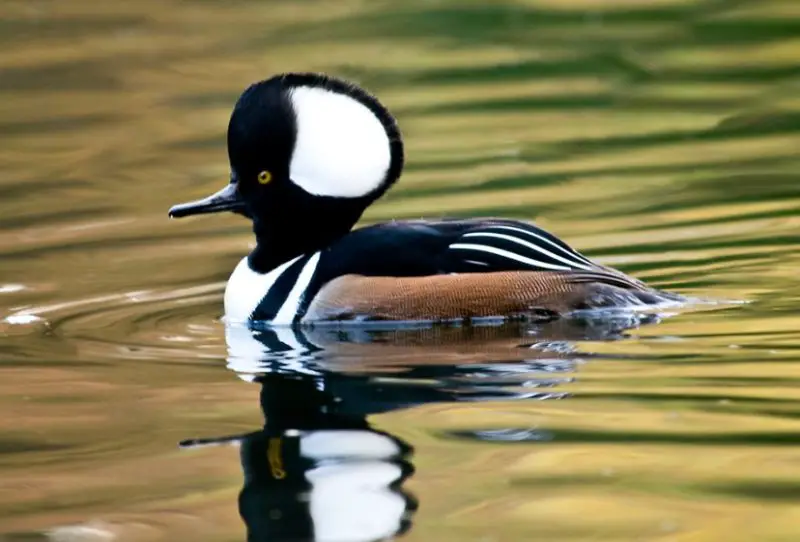
The Hooded Merganser is a small, striking diving duck with a fan-shaped crest that can be raised or lowered. Males have black and white patterns with a large white crest, while females are reddish-brown with a gray body and smaller crest. Adults measure 40–51 cm in length, with a wingspan of 66–73 cm and weigh 0.4–0.6 kg. Their crest and slender, serrated bill make them easy to distinguish from other ducks.
Hooded Mergansers prefer freshwater ponds, lakes, rivers, and forested wetlands. They dive to catch fish, aquatic insects, and crustaceans, often foraging near submerged logs or vegetation. They are agile divers and can make sudden, rapid movements to capture prey.
In Minnesota, Hooded Mergansers breed in wooded wetlands and small lakes across the state. They migrate south during winter, but some remain in southern Minnesota if open water is available. They are often seen in pairs or small groups and are highly valued by birdwatchers for their striking appearance.
Common Merganser (Mergus merganser)
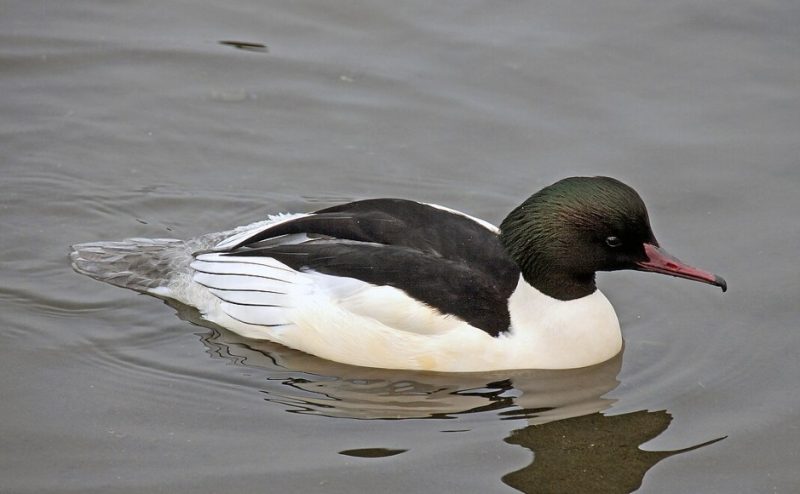
The Common Merganser is a large diving duck with a slender, serrated bill adapted for catching fish. Males have a dark green head, white body, and black back, while females have a reddish-brown head, gray body, and white chin. Adults measure 58–72 cm in length, with a wingspan of 78–97 cm and weigh 1–1.8 kg. Their streamlined body and long neck make them highly efficient in water.
Common Mergansers inhabit rivers, lakes, and reservoirs with clear water. They dive to catch fish, their primary food source, and may also eat aquatic invertebrates. These ducks often form small groups and forage actively, especially in winter when fish are abundant in open water areas.
In Minnesota, Common Mergansers breed along forested rivers and large lakes, particularly in northern regions. During migration, they pass through and winter on open water bodies in southern Minnesota and the Great Lakes region. They are often seen in pairs or family groups, making them a favorite for birdwatchers.
Red-breasted Merganser (Mergus serrator)
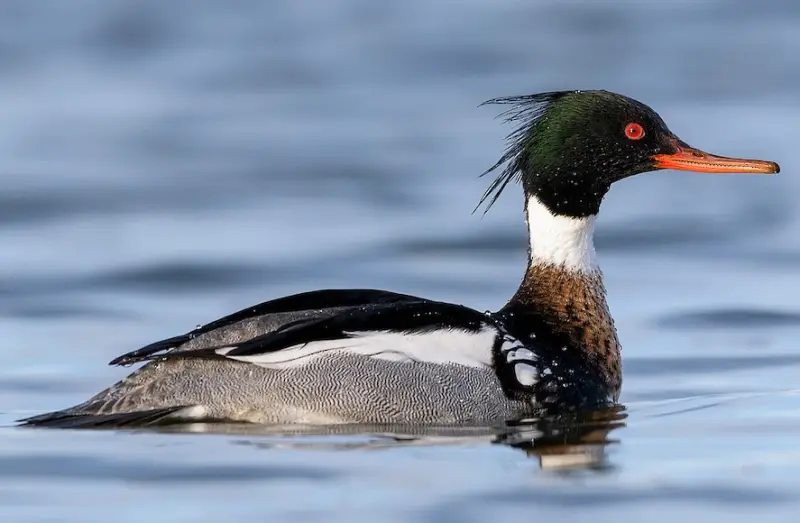
The Red-breasted Merganser is a medium-sized diving duck with a spiky crest and slender bill. Males have a dark green head, rusty chest, grayish body, and distinctive white neck ring, while females are gray-brown with a reddish head and white throat. Adults measure 51–62 cm in length, with a wingspan of 66–76 cm and weigh 0.7–1.1 kg. Their long, thin bill is adapted for catching fish in lakes and rivers.
Red-breasted Mergansers inhabit freshwater and coastal waters, including lakes, rivers, bays, and estuaries. They dive to capture small fish and aquatic invertebrates, often in small flocks. These ducks are highly agile in flight and capable of long-distance migration between breeding and wintering grounds.
In Minnesota, Red-breasted Mergansers are mostly seen during migration in fall and spring, using large lakes and reservoirs as stopover sites. They breed further north in Canada and Alaska and winter along the coasts of the northern United States. Sightings in Minnesota are more frequent on the state’s larger lakes and rivers.
Ruddy Duck (Oxyura jamaicensis)
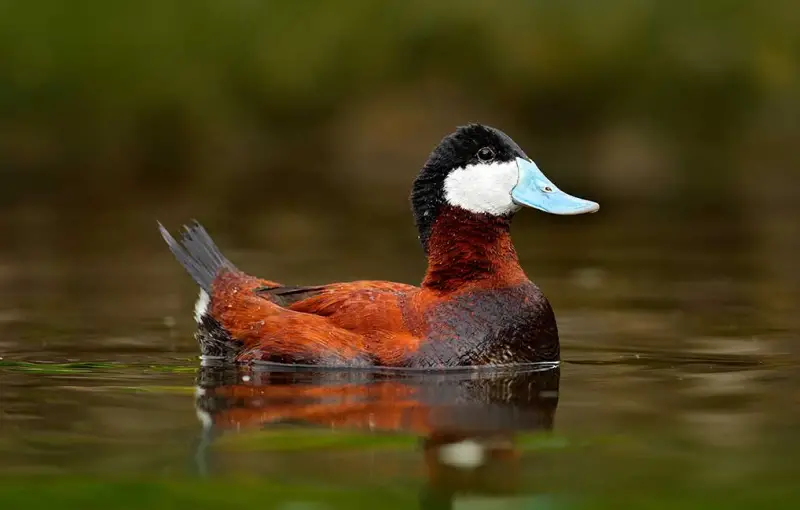
The Ruddy Duck is a small, stout diving duck with a characteristic stiff tail often held upright. Males are bright chestnut with a blue bill and blackish head during breeding season, while females are gray-brown with a darker cap and white cheek. Adults measure 36–41 cm in length, with a wingspan of 43–48 cm and weigh 0.4–0.6 kg. Their compact body and tail make them distinctive among small diving ducks.
Ruddy Ducks inhabit shallow marshes, ponds, and lakes with abundant vegetation. They feed by diving for seeds, aquatic plants, and small invertebrates, often remaining submerged for several seconds. They are known for their energetic courtship displays, including head-throwing and tail-raising behaviors.
In Minnesota, Ruddy Ducks breed in prairie potholes and shallow wetlands, with migration occurring in spring and fall. They winter in southern states and along the Gulf Coast. They are commonly seen in small groups and are adaptable to a variety of freshwater habitats.
Surf Scoter (Melanitta perspicillata)

The Surf Scoter is a large sea duck with a chunky body and thick bill. Males are mostly black with striking white patches on the forehead and nape, while females are dark brown with pale cheeks. Adults measure 45–54 cm in length, with a wingspan of 70–82 cm and weigh 0.9–1.5 kg. Their bold coloration and large bill make males easily identifiable from a distance.
Surf Scoters inhabit large lakes, reservoirs, and coastal waters. They dive for mollusks, crustaceans, and aquatic insects, often in small groups. They are strong fliers and highly migratory, moving long distances between breeding and wintering areas.
In Minnesota, Surf Scoters are primarily observed during migration on larger lakes in the fall and spring. They breed in northern boreal lakes and tundra regions of Canada and Alaska and winter along coastal waters of the U.S. Their presence in Minnesota is largely seasonal, often forming mixed flocks with other scoter species.
White-winged Scoter (Melanitta fusca)
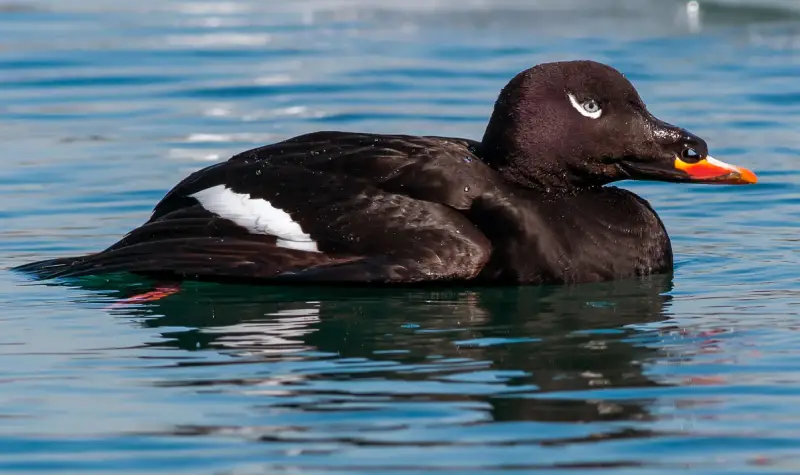
The White-winged Scoter is a large sea duck characterized by its bulky body and striking white wing patches visible in flight. Males are mostly black with a white patch on the wings and bill, while females are dark brown with paler cheeks. Adults measure 50–66 cm in length, with a wingspan of 83–96 cm and weigh 1–1.8 kg. They are powerful divers and strong fliers, well adapted to open water habitats.
White-winged Scoters inhabit large lakes, rivers, and coastal bays, diving for mollusks, crustaceans, and aquatic insects. They often forage in small groups and are highly social during migration and winter. Their strong diving ability allows them to exploit deeper water food sources.
In Minnesota, White-winged Scoters are mostly seen during migration on large lakes and reservoirs. They breed in northern Canada and Alaska and winter along coastal waters. Observations in Minnesota are usually concentrated on larger open water areas with abundant food.
Black Scoter (Melanitta americana)

The Black Scoter is a large, stocky sea duck with a predominantly black plumage in males and brownish tones in females. Males have a bulbous bill, while females are dark brown with paler cheeks. Adults measure 45–55 cm in length, with a wingspan of 75–90 cm and weigh 0.9–1.5 kg. Their dark plumage and bulky profile distinguish them from other scoters.
Black Scoters inhabit large lakes, rivers, and coastal waters. They dive for mollusks, crustaceans, and small fish, often forming large flocks during migration. They are social birds and frequently associate with White-winged and Surf Scoters in mixed flocks.
In Minnesota, Black Scoters are primarily observed during migration in fall and spring, especially on large open lakes and reservoirs. They breed in northern Canada and winter along the Atlantic and Pacific coasts. Sightings in Minnesota are seasonal and generally involve small to moderate-sized groups.
Long-tailed Duck (Clangula hyemalis)
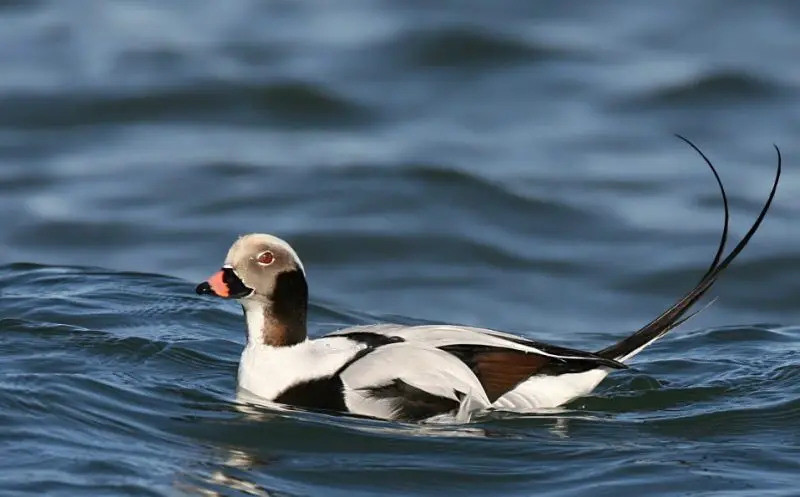
The Long-tailed Duck is a medium-sized sea duck known for its long, pointed tail feathers in males and striking winter plumage. Males display a white and dark brown pattern with a long tail, while females are mottled gray-brown with a shorter tail. Adults measure 40–50 cm in length, with a wingspan of 76–86 cm and weigh 0.7–1.2 kg. Their distinctive tail and vocalizations make them easy to identify.
Long-tailed Ducks inhabit large lakes, coastal bays, and open waters, diving to feed on crustaceans, mollusks, and small fish. They are highly social and often seen in flocks, particularly during migration. Their diving ability allows them to forage in deep water.
In Minnesota, Long-tailed Ducks are mostly observed during winter on large lakes and reservoirs. They breed in Arctic tundra regions of Canada and Alaska and migrate southward, with Minnesota serving as a stopover and wintering area. They are relatively uncommon inland, making sightings noteworthy.
Ring-necked Pochard (Aythya collaris)
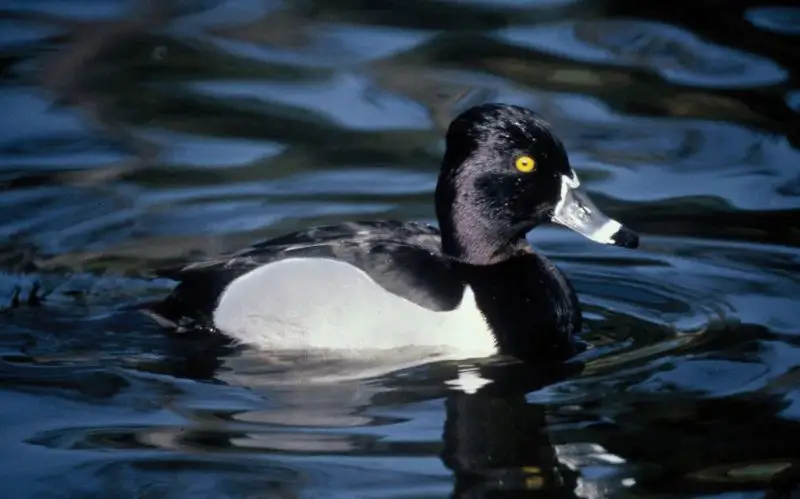
The Ring-necked Pochard is a diving duck that is rare in Minnesota. Males have a chestnut head, black breast, and gray body, while females are mottled brown with paler faces. Adults measure 42–51 cm in length, with a wingspan of 70–80 cm and weigh 0.7–1.1 kg. Their name comes from the subtle chestnut ring around the neck, which can be difficult to see in the field.
Ring-necked Pochards inhabit freshwater lakes, ponds, and marshes with abundant submerged vegetation. They dive to feed on seeds, aquatic plants, and invertebrates, often foraging alone or in small groups. They are more secretive than other diving ducks.
In Minnesota, Ring-necked Pochards are very rare, usually appearing as vagrants during migration. Most sightings occur in southern lakes or managed wetlands. Their scarcity makes them a prized find for birdwatchers visiting the state.
Hooded Merganser (Lophodytes cucullatus)

The Hooded Merganser is a small diving duck with a fan-shaped crest that can be raised or lowered. Males have black and white patterns with a large white crest, while females are reddish-brown with a gray body and smaller crest. Adults measure 40–51 cm in length, with a wingspan of 66–73 cm and weigh 0.4–0.6 kg. Their crest and slender, serrated bill make them easy to distinguish from other ducks.
Hooded Mergansers prefer freshwater ponds, lakes, rivers, and forested wetlands. They dive to catch fish, aquatic insects, and crustaceans, often foraging near submerged logs or vegetation. They are agile divers and can make sudden, rapid movements to capture prey.
In Minnesota, Hooded Mergansers breed in wooded wetlands and small lakes across the state. They migrate south during winter, but some remain in southern Minnesota if open water is available. They are often seen in pairs or small groups and are highly valued by birdwatchers for their striking appearance.
Lesser White-fronted Goose (Anser erythropus)

The Lesser White-fronted Goose is a small and rare migratory goose with a gray-brown body, pinkish legs, and a distinctive white facial patch around the base of the bill. Adults measure 56–66 cm in length, with a wingspan of 130–150 cm and weigh 1.8–2.5 kg. Their small size and pale facial markings help distinguish them from the more common Greater White-fronted Goose.
This species inhabits wetlands, ponds, and tundra regions, feeding on grasses, sedges, and grains. They are social birds, typically forming small flocks during migration and wintering periods. They are cautious and often remain near water for safety.
In Minnesota, Lesser White-fronted Geese are extremely rare, appearing only occasionally during spring or fall migration. Sightings are considered exceptional, usually involving small groups in northern prairie wetlands or open fields.
Red-breasted Merganser (Mergus serrator)
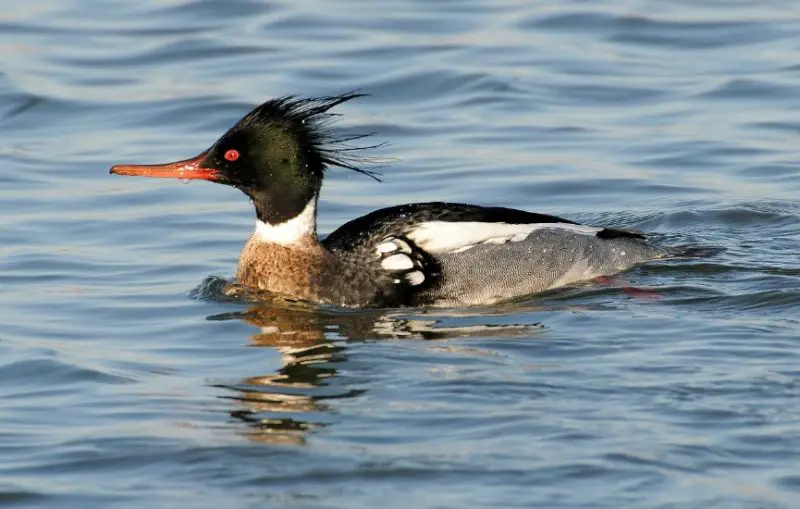
The Red-breasted Merganser is a medium-sized diving duck with a spiky crest and slender bill. Males have a dark green head, rusty chest, grayish body, and distinctive white neck ring, while females are gray-brown with a reddish head and white throat. Adults measure 51–62 cm in length, with a wingspan of 66–76 cm and weigh 0.7–1.1 kg. Their long, thin bill is adapted for catching fish in lakes and rivers.
Red-breasted Mergansers inhabit freshwater and coastal waters, including lakes, rivers, bays, and estuaries. They dive to capture small fish and aquatic invertebrates, often in small flocks. These ducks are highly agile in flight and capable of long-distance migration between breeding and wintering grounds.
In Minnesota, Red-breasted Mergansers are mostly seen during migration in fall and spring, using large lakes and reservoirs as stopover sites. They breed further north in Canada and Alaska and winter along the coasts of the northern United States. Sightings in Minnesota are more frequent on the state’s larger lakes and rivers.
Smew (Mergellus albellus)
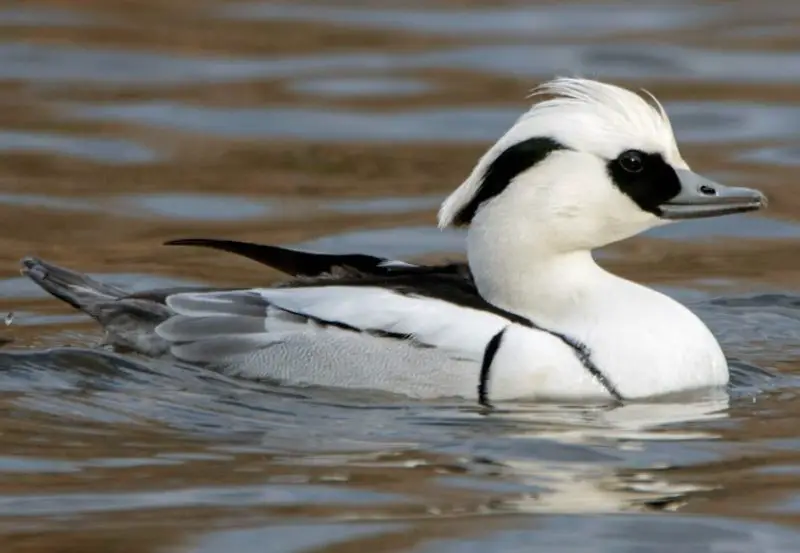
The Smew is a small, striking merganser that is very rare in Minnesota, primarily seen during winter. Males are predominantly white with black markings and a distinctive black mask, while females are gray with reddish-brown heads. Adults measure 40–44 cm in length, with a wingspan of 58–70 cm and weigh 0.4–0.5 kg. Their contrasting plumage and small size make them highly noticeable when present.
Smews inhabit freshwater lakes, rivers, and forested wetlands, diving for small fish, aquatic insects, and crustaceans. They are agile hunters and often forage in pairs or small groups. These ducks are highly migratory, moving south from northern Europe and Siberia.
In Minnesota, Smews are extremely rare, mostly appearing during harsh winters when northern populations move south. Sightings are typically limited to large lakes or reservoirs, making them a prized observation for birdwatchers in the state.
FAQs about Ducks and Waterfowl in Minnesota
What are the most common ducks in Minnesota?
Some of the most common ducks in Minnesota include Mallard, Wood Duck, Northern Pintail, Gadwall, Blue-winged Teal, and Canvasback. These species can be observed in wetlands, lakes, ponds, and rivers throughout the state.
When is the best time to watch ducks in Minnesota?
The best times to observe ducks are during migration seasons in spring (March–May) and fall (September–November). Some species, such as Mallards and Wood Ducks, can also be seen year-round, especially in southern Minnesota where water bodies remain unfrozen.
Where can I see rare duck species in Minnesota?
Rare species like the Smew, Ring-necked Pochard, and Lesser White-fronted Goose are usually seen during migration or winter. They are often found on larger lakes, reservoirs, or northern prairie wetlands. Sightings are infrequent and considered a special event for birdwatchers.
How can I identify male and female ducks?
Male ducks often display brighter plumage with distinctive colors or patterns, while females are generally mottled brown or gray to provide camouflage during nesting. Observing wing patches, bills, size, and behavior can also help with identification.
Do all ducks migrate in Minnesota?
Most duck species in Minnesota migrate seasonally. Some species, like Mallards and Wood Ducks, may remain year-round if open water is available. Diving ducks such as Canvasbacks, Scaups, and Goldeneyes often migrate south in winter to avoid frozen lakes.
What habitats do Minnesota ducks prefer?
Ducks occupy a variety of habitats including shallow wetlands, marshes, lakes, rivers, reservoirs, forested ponds, and prairie potholes. Different species have specific preferences, such as diving ducks for deeper lakes and dabblers for shallow marshes.
Are there any endangered or threatened duck species in Minnesota?
While most common ducks are abundant, rare visitors like the Lesser White-fronted Goose and Smew are considered highly unusual in Minnesota. Conservation of wetlands is crucial to protect habitats for breeding and migratory species.
Can I feed ducks in Minnesota?
It is generally discouraged to feed wild ducks, especially bread, as it can harm their health and the ecosystem. Instead, observe them in their natural habitats and enjoy birdwatching responsibly.


